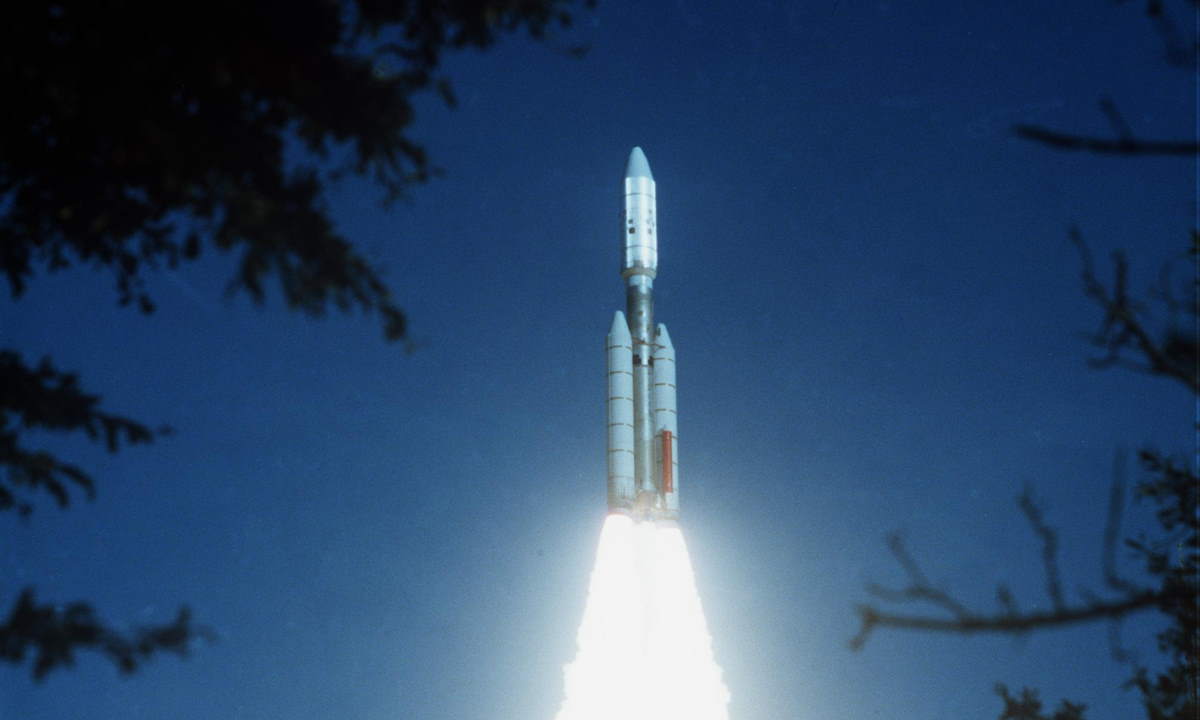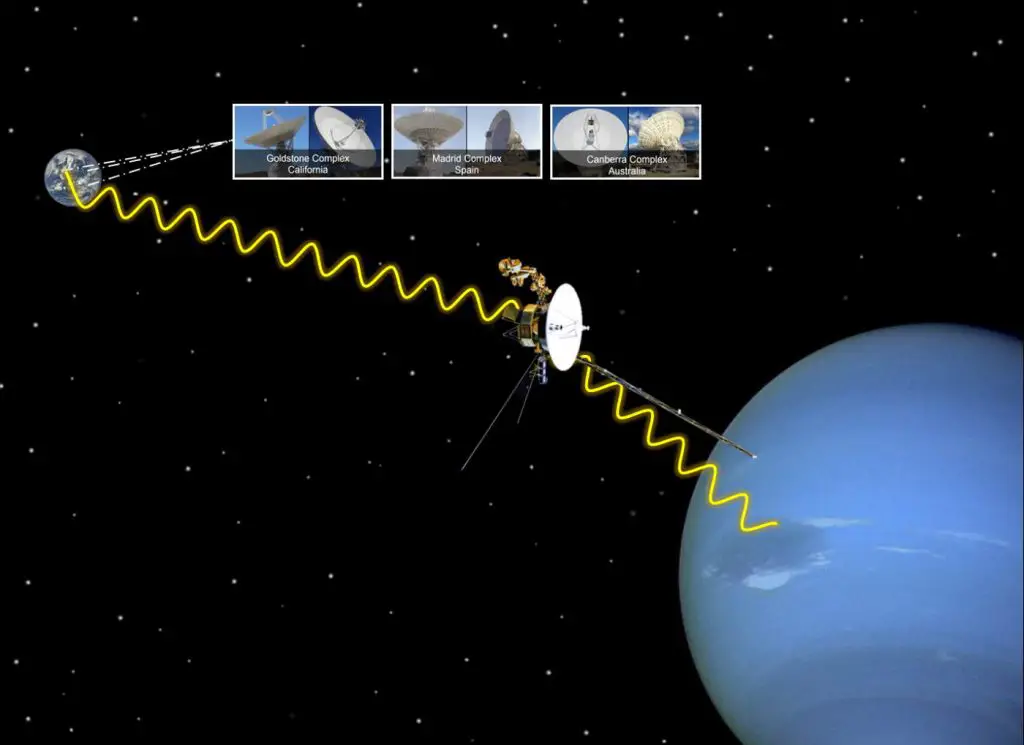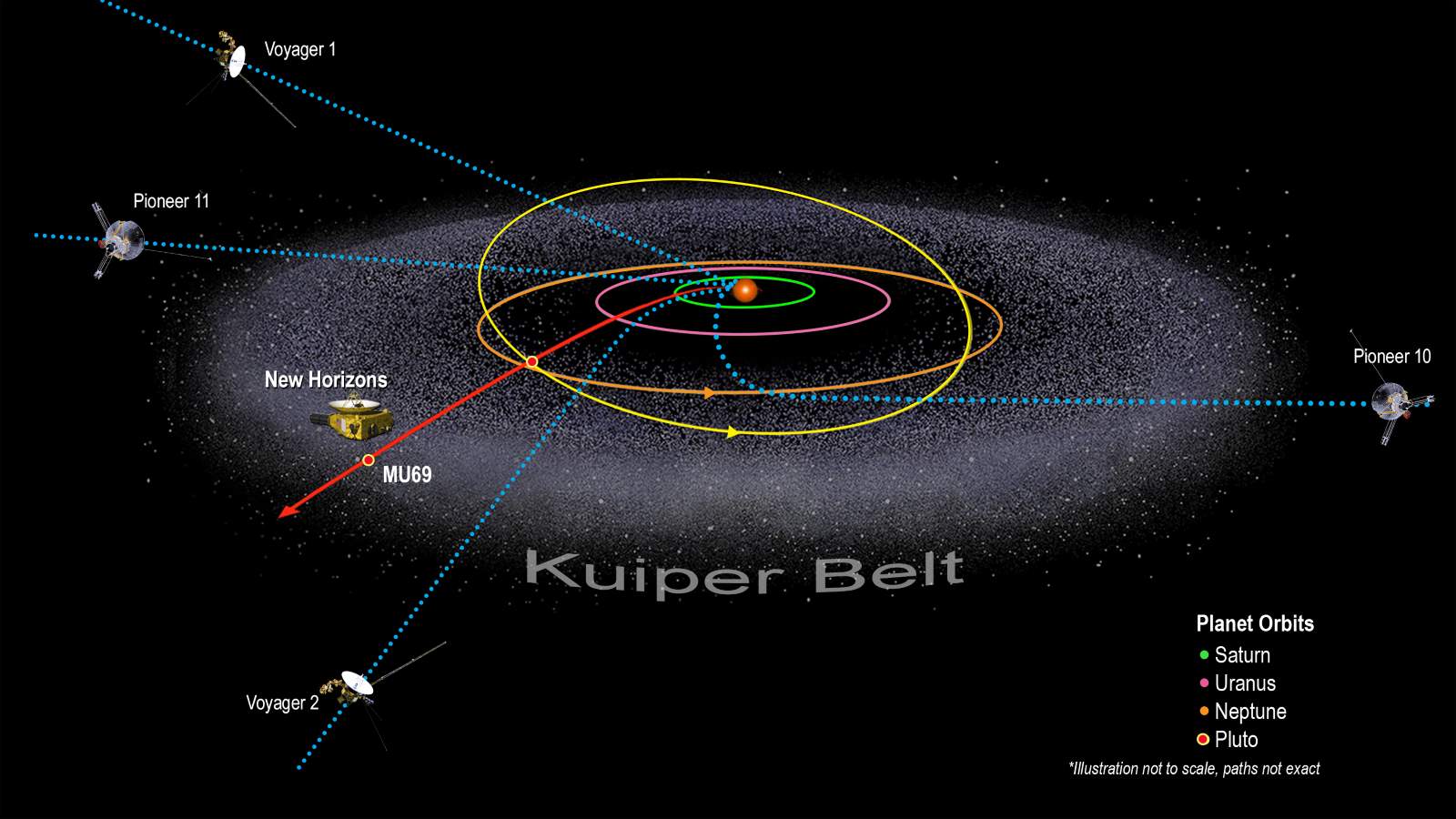On August 20, 1977, Voyager 2 was launched from Cape Canaveral on top of a Titan IIIE-Centaur rocket. It launched before Voyager 1, which was sent into space on September 5, 1977.
Today’s (August 20) story of what happened this day in Science, Technology, Astronomy, and Space Exploration history.
Voyager 2 – Timeline of Travel and Important Events
August 20, 1977: Voyager 2 launched into space
Voyager 2 was launched on August 20, 1977, 16 days before the September 5 launch of its twin, Voyager 1. Why the reversal of order? The two were sent on different trajectories, and Voyager 1 was put on a path to reach its planetary targets, Jupiter and Saturn, ahead of Voyager 2.
Like its twin, the Voyager 2 was launched to study the outer planets of the Solar System and interstellar space beyond the Sun’s heliosphere (the magnetosphere and the outermost atmospheric layer of the Sun, the heliosphere is regarded as the border of the Solar System).
December 10, 1977: Entered Asteroid Belt
The asteroid belt is a torus-shaped region located roughly between the orbits of the planets Jupiter and Mars. It contains a great many solid, irregularly shaped bodies, of many sizes. They are much smaller than planets, though, so they are called asteroids or minor planets.
December 19, 1977: Voyager 1 overtakes Voyager 2
Although Pioneer probes (10, 11) and Voyager 2 were launched first, Voyager 1 has achieved a higher speed and overtaken all others. Voyager 1 overtook Voyager 2 just a few months after launch, on December 19, 1977.
Then it overtook Pioneer 11 (launched on April 6, 1973) in 1983, and then Pioneer 10 (launched on March 3, 1972) on February 17, 1998, becoming the farthest spacecraft from Earth.
October 21, 1978: Exited Asteroid Belt
The width of the asteroid belt is roughly 1 AU (the distance between Earth and the Sun), or 92 million miles (150 million km). It took more than 10 months for Voyager 2 to travel through it.
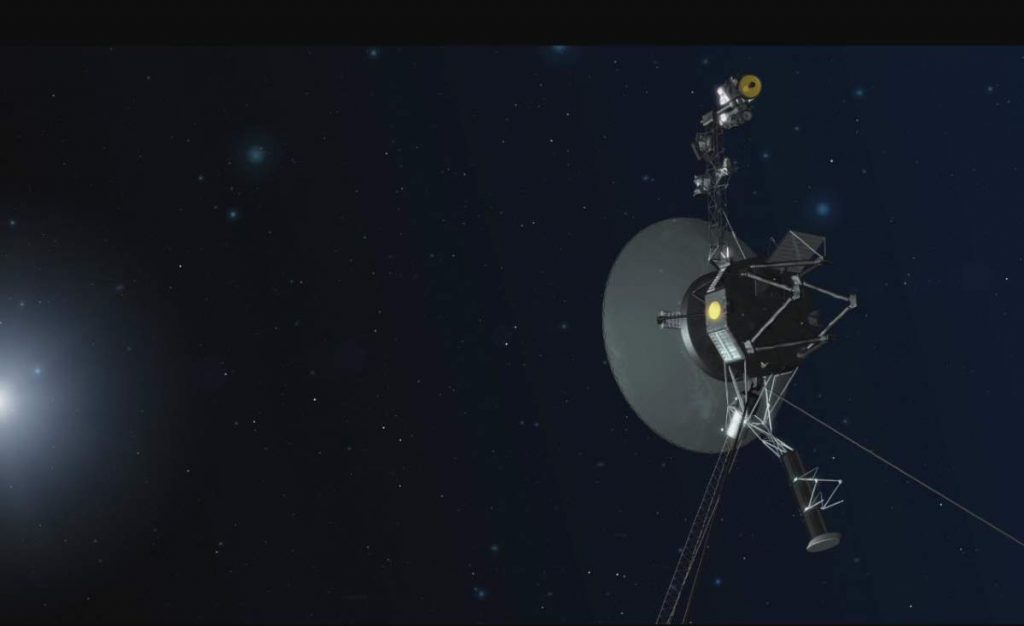
July 9, 1979: Jupiter flyby
The space probe performed the Jupiter flyby with the closest approach at 721,670 km (448,425 miles) from the center of mass of the gas giant.
During its inbound journey toward the planet, Voyager 2 made flybys of several of Jupiter’s moons – 133,600 miles of Callisto, 38,600 miles of Ganymede (the largest moon of Jupiter and in the Solar System), 127,900 miles of Europa, and 347,000 miles of Amalthea.
On July 9, 1979, Voyager 2 made its closest approach to Jupiter, flying within 350,000 miles (563, 270 km) of the planet’s cloud tops.
On the outbound leg of its Jupiter encounter, it imaged the satellite Io (closest approach of 702,200 miles), and conducted a 10-hour volcano watch of the moon, confirming Voyager 1’s finding that it harbored active volcanoes.
Voyager 2 revealed the Great Red Spot to be a complex storm system and also imaged several smaller storms in the planet’s atmosphere.
High-resolution photographs of Europa revealed extensive irregular markings on its surface, possibly indicating a frozen crust floating atop a deep ocean.
Looking back at Jupiter as it was backlit by the Sun, the space probe confirmed the existence of a thin ring surrounding the planet.
Voyager 2 also discovered a previously unknown moon, later named Adrastea, orbiting Jupiter just outside its rings.
By the time observations of Jupiter concluded on August 5, 1979, the spacecraft had returned 17,000 images of the gas giant and its satellites.

August 26, 1981: Saturn flyby
More than two years after its successful exploration of the Jovian system, Voyager 2 performed the Saturn flyby with the closest approach at 161,000 km (100,000 miles) from the center of the mass of Saturn (Voyager 1 performed its Saturn flyby on November 12, 1980).
These two Saturn encounters of the Voyager spacecraft increased our knowledge and altered our understanding of Saturn (see notes 1).
During its encounter in August 1981, the spacecraft returned a wealth of information about the planet, its spectacular rings, and its satellites.
Both Voyager spacecraft measured the rotation of Saturn (the length of a Saturnian day) at 10 hours, 39 minutes, and 24 seconds.
Saturn’s gravity altered Voyager 2’s trajectory to send it to encounter Uranus in January 1986, where it carried out the first reconnaissance of that planet, its satellites, and its rings.

January 24, 1986: Uranus flyby
Voyager 2 flew closely past distant Uranus, the seventh planet from the Sun, in January 1986. At its closest, the spacecraft came within 81,500 kilometers (50,600 miles) of Uranus’s cloud tops on January 24, 1986.
Voyager 2 radioed thousands of images and voluminous amounts of other scientific data on the planet, its moons, rings, atmosphere, interior, and the magnetic environment surrounding Uranus.
Voyager 2’s images of the five largest moons around Uranus (Miranda, Ariel, Umbriel, Titania, and Oberon, which range in diameter from 472 km / 293 mi for Miranda to 1578 km / 980 mi for Titania) revealed complex surfaces indicative of varying geologic pasts. The cameras also detected 11 previously unseen moons.
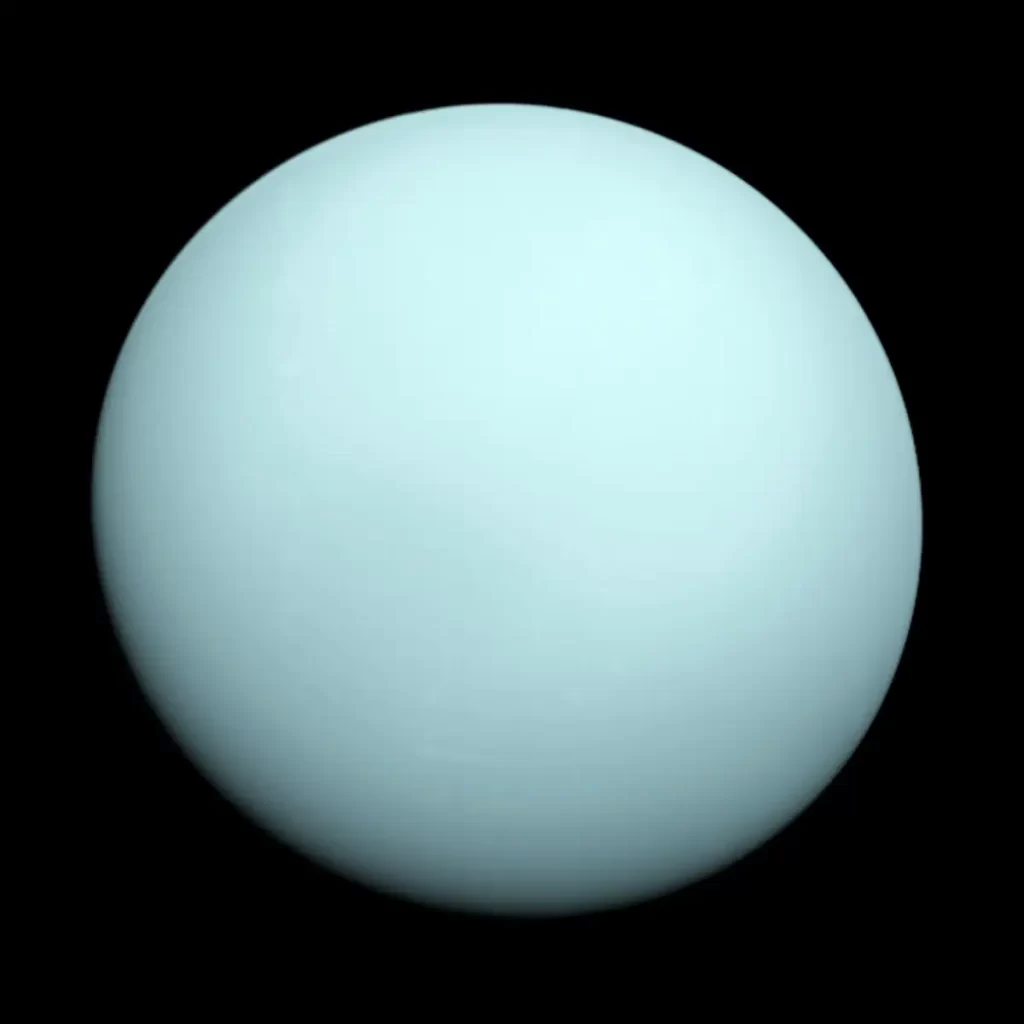
August 20, 1987: 10 years in space
At this point, Voyager 2 celebrates 10 years of continuous flight and operation.
August 25, 1989: Neptune flyby
On August 25, 1989, Voyager 2 made a close flyby of Neptune, giving humanity its first close-up of our solar system’s eighth (and the outermost) planet. Marking the end of the Voyager mission’s Grand Tour of the solar system’s four giant planets – Jupiter, Saturn, Uranus, and Neptune – that first was also a last: No other spacecraft has visited Neptune since.
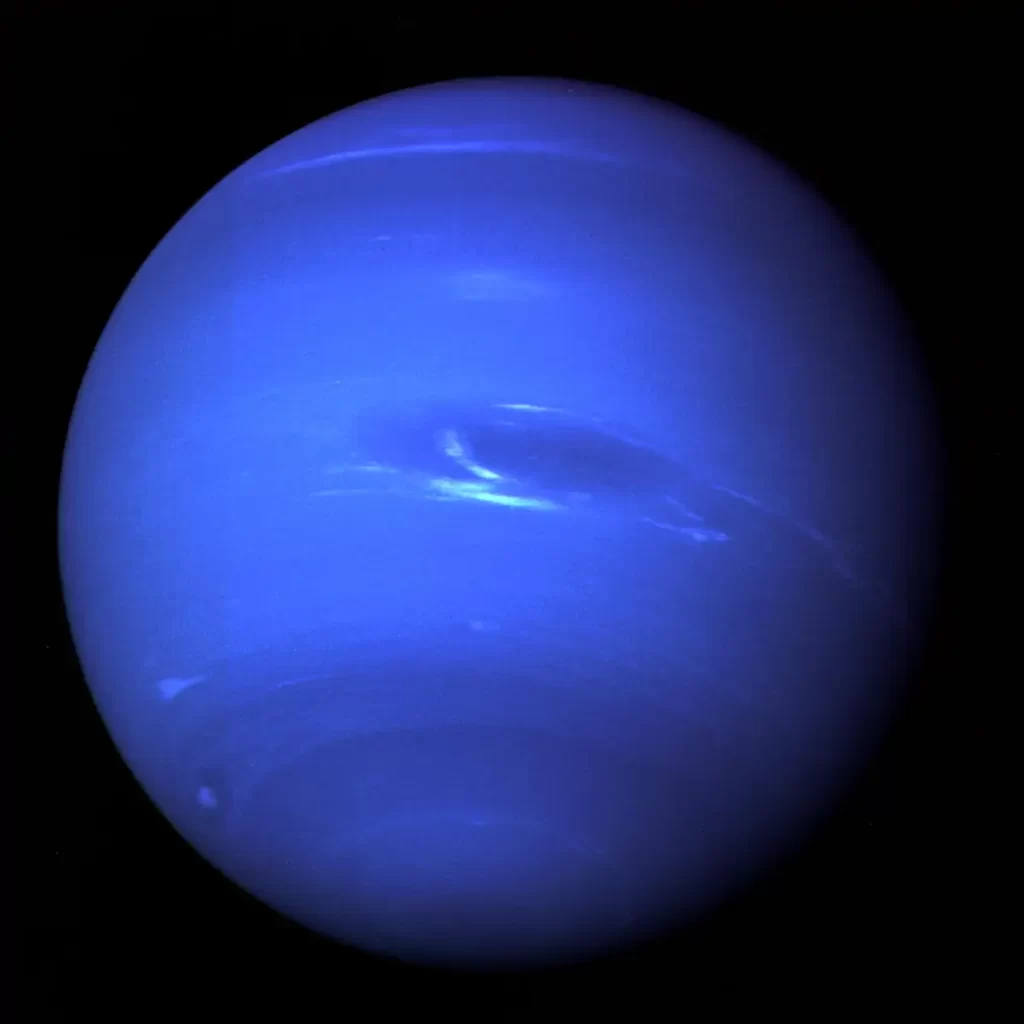
During the encounter, the Voyager 2 engineering team carefully changed the probe’s direction and speed so that it could do a close flyby of Neptune’s largest moon, Triton. The flyby showed evidence of geologically young surfaces and active geysers spewing material skyward. This indicated that Triton was not simply a solid ball of ice, even though it had the lowest surface temperature of any natural body observed by Voyager: minus 391 degrees Fahrenheit (minus 235 degrees Celsius).
With a radius of 1,350 km (839 mi), about 22% smaller than Earth’s moon, Triton is by far the largest satellite of Neptune.
It is one of only three objects in the Solar System known to have a nitrogen-dominated atmosphere (the others are Earth and Saturn’s giant moon, Titan).
Triton has the coldest surface known anywhere in the Solar System (38 K, about -235 °C or -391 °F); it is so cold that most of Triton’s nitrogen is condensed as frost, making it the only satellite in the Solar System known to have a surface made mainly of nitrogen ice.
The pinkish deposits (see the image below) constitute a vast south polar cap believed to contain methane ice, which would have reacted under sunlight to form pink or red compounds. The dark streaks overlying these pink ices are believed to be an icy and perhaps carbonaceous dust deposited from huge geyser-like plumes, some of which were found to be active during the Voyager 2 flyby.
The bluish-green band visible in this image extends all the way around Triton near the equator; it may consist of relatively fresh nitrogen frost deposits. The greenish areas include what is called the cantaloupe terrain, whose origin is unknown, and a set of “cryovolcanic” landscapes apparently produced by icy-cold liquids (now frozen) erupted from Triton’s interior.

About 30 times farther from the Sun than Earth is, Neptune receives only about 0.001 times the amount of sunlight that Earth does. In such low light, Voyager 2’s camera required longer exposures to get quality images. But because the spacecraft would reach a maximum speed of about 60,000 mph (90,000 km/h) relative to Earth, a long exposure time would make the image blurry. (Imagine trying to take a picture of a roadside sign from the window of a speeding car.)
So the team programmed Voyager 2’s thrusters to fire gently during the close approach, rotating the spacecraft to keep the camera focused on its target without interrupting the spacecraft’s overall speed and direction.
October 2, 1989: Voyager 2 Interstellar Mission has begun
The conclusion of the Neptune flyby marked the beginning of the Voyager Interstellar Mission.
August 20, 1997: 20 years in space
At this point, Voyager 2 celebrates 20 years of continuous flight and operation.
August 20, 2007: 30 years in space
At this point, Voyager 2 celebrates 30 years of continuous flight and operation.
August 20, 2017: 40 years in space
At this point, Voyager 2 celebrates 40 years of continuous flight and operation.
November 5, 2018: Voyager 2 enters interstellar space
For the second time in history, a human-made object has reached the space between the stars (Voyager 1 entered interstellar space on August 25, 2012).
On November 5, 2018, the Voyager 2 probe exited the heliosphere – the protective bubble of particles and magnetic fields created by the Sun.
Voyager 2 is not headed toward any particular star, although in roughly 40,000 years it should pass 1.7 light-years from the star Ross 248.
If undisturbed for 296,000 years, it should pass by the star Sirius, the brightest star in the night sky, at a distance of 4.3 light-years (Sirius is 8.6 light-years from the Sun).

Video: Voyager 2 Trajectory through the Solar System
This 2017 visualization tracks the trajectory of the Voyager 2 spacecraft through the solar system. Launched on August 20, 1977, it was one of two spacecraft sent to visit the giant planets of the outer solar system. Like Voyager 1, Voyager 2 flew by Jupiter and Saturn, but the Voyager 2 mission was extended to fly by Uranus and Neptune before being directed out of the solar system.
To fit the 40-year history of the mission into a short visualization, the pacing of time accelerates through most of the movie, starting at about 5 days per second in the beginning and speeding up to about 11 months per second after the planet flybys are passed.
The termination shock and heliopause are the “boundaries” created when the plasma between the stars interacts with the plasma flowing outward from the Sun. They are represented with simple grid models and oriented so their ‘nose’ is pointed in the direction (Right Ascension = 17h 24m, declination = 17 degrees south) represented by more recent measurements from other missions.
Credit: NASA’s Scientific Visualization Studio
Voyager 2 trajectory (images)
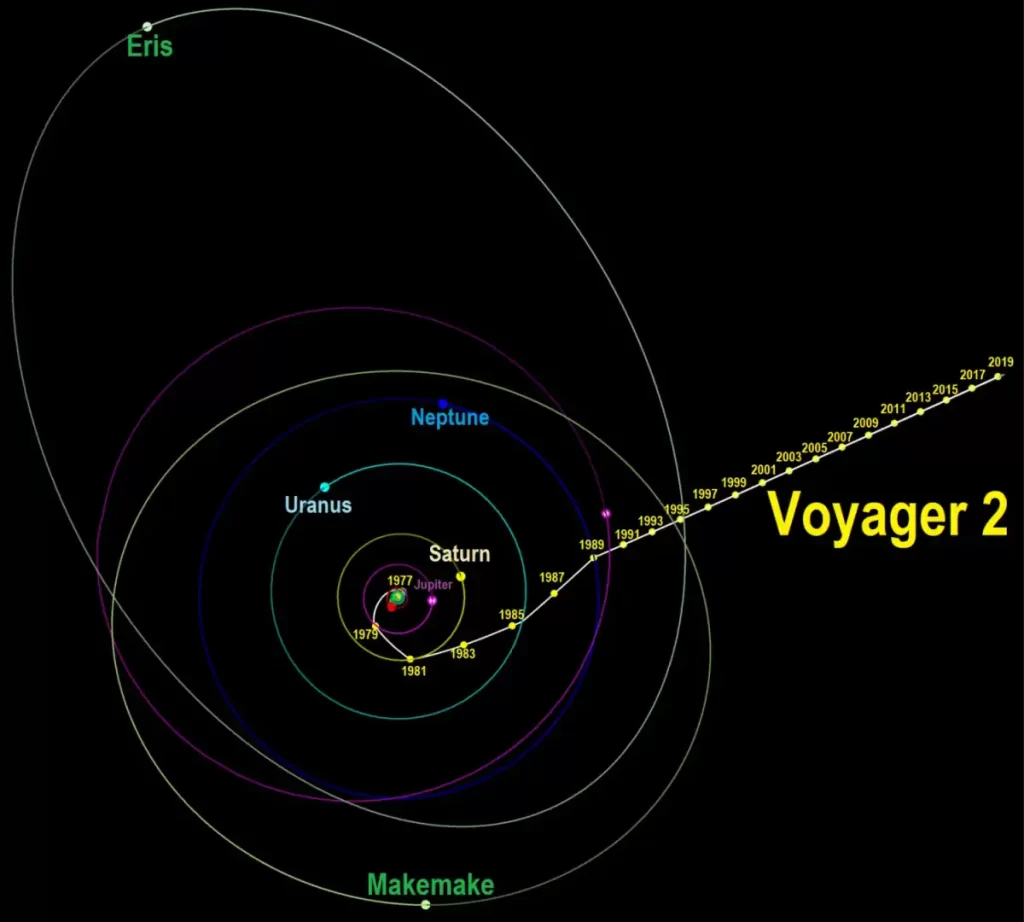
Along with fellow dwarf planets Pluto, Eris, and Haumea, Makemake is located in the Kuiper Belt, a donut-shaped region of icy bodies beyond the orbit of Neptune.
Slightly smaller than Pluto (radius: 1,188.3 km / 738.4 miles), Makemake (mean radius of about 715 km / 444 miles) is the second-brightest object in the Kuiper Belt as seen from Earth (while Pluto is the brightest). It takes about 305 Earth years for this dwarf planet to make one trip around the Sun.
Makemake holds an important place in the history of solar system studies because it – along with Eris – was one of the objects whose discovery prompted the International Astronomical Union to reconsider the definition of a planet and to create a new group of dwarf planets.
Makemake was first observed in March 2005 by M.E. Brown, C.A. Trujillo, and D.L. Rabinowitz at the Palomar Observatory.
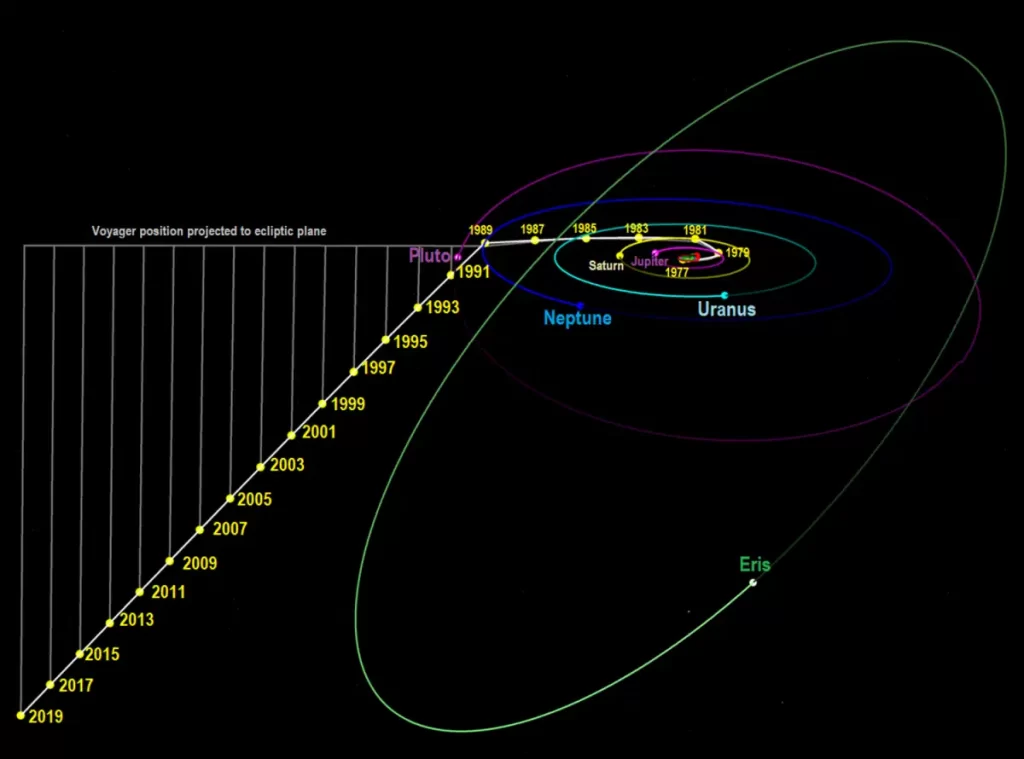
Named after the Greek goddess of strife and discord, Eris is the most massive and second-largest (by volume) dwarf planet (and plutoid) in the known Solar System. Its discovery in January 2005 by a Palomar Observatory-based team led by California Institute of Technology’s (Caltech) Mike Brown is the reason why Pluto is no longer a planet.
NASA’s New Horizons spacecraft measured Eris’ diameter as 2,372 ± 4 km (1,473.9 ± 2.5 mi) in July 2015.
August 20 in Science, Technology, Astronomy, and Space Exploration history
- 1960: First animals and plants returned alive from space
- 1977: Voyager 2 was launched
Notes
- Here is a summary of scientific findings by the two Voyagers at Saturn:
- Saturn’s atmosphere is almost entirely hydrogen and helium. Voyager 1 found that about 7 percent of the volume of Saturn’s upper atmosphere is helium (compared with 11 percent of Jupiter’s atmosphere), while almost all the rest is hydrogen. Since Saturn’s internal helium abundance was expected to be the same as Jupiter’s and the Sun’s, the lower abundance of helium in the upper atmosphere may imply that the heavier helium may be slowly sinking through Saturn’s hydrogen; that might explain the excess heat that Saturn radiates over energy it receives from the Sun. (Saturn is the only planet less dense than water. In the unlikely event that a lake could be found large enough, Saturn would float in it.)
- Subdued contrasts and color differences on Saturn could be a result of more horizontal mixing or less production of localized colors than in Jupiter’s atmosphere. While Voyager 1 saw few markings, Voyager 2’s more sensitive cameras saw many: Long-lived ovals, tilted features in east-west shear zones, and others similar to, but generally smaller than those on Jupiter.
- Winds blow at high speeds in Saturn. Near the equator, the Voyagers measured winds at about 500 meters a second (1,100 mph or 1,770 km/h). The wind blows mostly in an easterly direction. The strongest winds are found near the equator, and velocity falls off uniformly at higher latitudes. At latitudes greater than 35 degrees, winds alternate east and west as latitude increases. Marked dominance of eastward jet streams indicates that winds are not confined to the cloud layer, but must extend inward at least 2,000 kilometers (1,200 miles). Furthermore, measurements by Voyager 2 show a striking north-south symmetry that leads some scientists to suggest the winds may extend from north to south through the interior of the planet.
- While Voyager 2 was behind Saturn, its radio beam penetrated the upper atmosphere and measured temperature and density. Minimum temperatures of 82 Kelvins (-191 °C or -312 °F) were found at the 70-millibar level (surface pressure on Earth is 1,000 millibars). The temperature increased to 143 Kelvins (-130 °C or -202 °F) at the deepest levels probed – about 1,200 millibars. Near the north pole, temperatures were about 10 °C (18 °F) colder at 100 millibars than at mid-latitudes. The difference may be seasonal.
- The Voyagers found aurora-like ultraviolet emissions of hydrogen at mid-latitudes in the atmosphere and auroras at polar latitudes (above 65 degrees). The high-level auroral activity may lead to the formation of complex hydrocarbon molecules that are carried toward the equator. The mid-latitude auroras, which occur only in sunlit regions, remain a puzzle, since bombardment by electrons and ions, known to cause auroras on Earth, occurs primarily at high latitudes.
Sources
- Voyager mission page on the NASA website
- Voyager 2 mission page on the NASA Solar System Exploration website
- Voyager 2 Interstellar Mission page on the NASA Jet Propulsion Laboratory website
- Voyager 2 Mission Status on the NASA Jet Propulsion Laboratory website
- Voyager 2 Mission Overview on the NASA Jet Propulsion Laboratory website
- “Voyager 2 Explores Jupiter” on the NASA website
- “Voyager 2 Uranus Approach” on the NASA Jet Propulsion Laboratory website
- “Voyager 2’s Historic Neptune Flyby” on the NASA website
- “NASA’s Voyager 2 Probe Enters Interstellar Space” on the NASA Jet Propulsion Laboratory website
- Voyager 2 on Wikipedia
- Moon Landings: All-Time List [1966-2025] - February 2, 2025
- What Is Max-Q and Why Is It Important During Rocket Launches? - January 16, 2025
- Top 10 Tallest Rockets Ever Launched [2025 Update] - January 16, 2025
